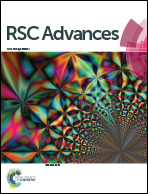Structures and energies of the transition between two conformations of the alternate frame folding calbindin-D9k protein: a theoretical study†
Abstract
We carried out conventional molecular dynamics simulations, targeted molecular dynamics simulations and energy calculations for the two states (AFF-D9k-N′ and AFF-D9k-N) of the alternate frame folding (AFF) calbindin-D9k protein and their conformational transition in the Ca2+-free form to address the dynamical transition mechanism from AFF-D9k-N′ to AFF-D9k-N states. We found that the structural characteristics of the two stable AFF-D9k-N′ and AFF-D9k-N states present the coupled conformations of mutually exclusive folding. The transition from AFF-D9k-N′ to AFF-D9k-N states may occur via two transition states and an intermediate with the first rate-controlling barrier of 4.7 kcal mol−1 and the second barrier of 1.7 kcal mol−1. These results showed that the conformational transition pathway from AFF-D9k-N′ to AFF-D9k-N is energetically feasible due to the low rate-controlling barrier. Moreover, the stabilities of the AFF-D9k-N′ and AFF-D9k-N conformations calculated by the MM_PBSA method are consistent with the available experimental result. The transition mechanism involves the relative movements of the two mutually exclusive folding regions, EF2 and EF2′, and their coupled folding-unfolding. The crucial mediation of the deformation of EF1 hand located at the middle of the AFF calbindin-D9k protein plays a key role in this transition process. The correlation analysis revealed the allosteric communications between the EF2′ and EF2 regions via the mediation of the EF1 hand during the transition of AFF-D9k-N′ to AFF-D9k-N.


 Please wait while we load your content...
Please wait while we load your content...